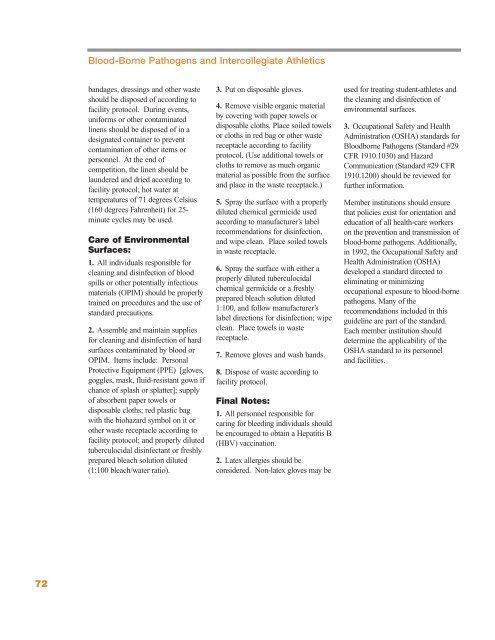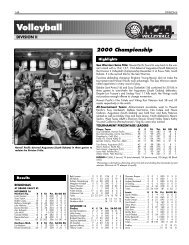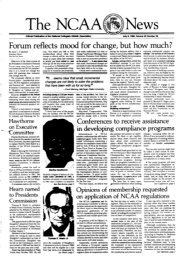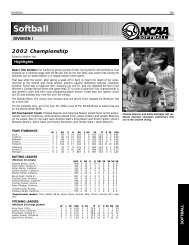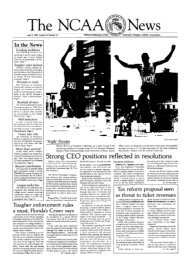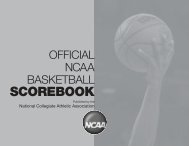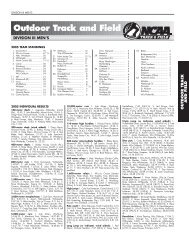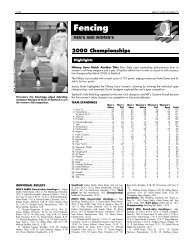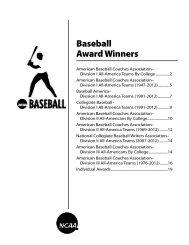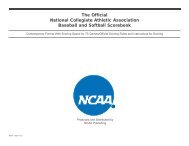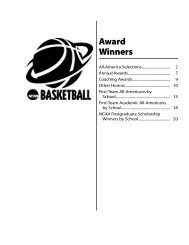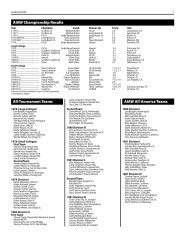Sports Medicine Handbook - NCAA
Sports Medicine Handbook - NCAA
Sports Medicine Handbook - NCAA
Create successful ePaper yourself
Turn your PDF publications into a flip-book with our unique Google optimized e-Paper software.
72<br />
Blood-Borne Pathogens and Intercollegiate Athletics<br />
bandages, dressings and other waste<br />
should be disposed of according to<br />
facility protocol. During events,<br />
uniforms or other contaminated<br />
linens should be disposed of in a<br />
designated container to prevent<br />
contamination of other items or<br />
personnel. At the end of<br />
competition, the linen should be<br />
laundered and dried according to<br />
facility protocol; hot water at<br />
temperatures of 71 degrees Celsius<br />
(160 degrees Fahrenheit) for 25minute<br />
cycles may be used.<br />
Care of Environmental<br />
Surfaces:<br />
1. All individuals responsible for<br />
cleaning and disinfection of blood<br />
spills or other potentially infectious<br />
materials (OPIM) should be properly<br />
trained on procedures and the use of<br />
standard precautions.<br />
2. Assemble and maintain supplies<br />
for cleaning and disinfection of hard<br />
surfaces contaminated by blood or<br />
OPIM. Items include: Personal<br />
Protective Equipment (PPE) [gloves,<br />
goggles, mask, fluid-resistant gown if<br />
chance of splash or splatter]; supply<br />
of absorbent paper towels or<br />
disposable cloths; red plastic bag<br />
with the biohazard symbol on it or<br />
other waste receptacle according to<br />
facility protocol; and properly diluted<br />
tuberculocidal disinfectant or freshly<br />
prepared bleach solution diluted<br />
(1:100 bleach/water ratio).<br />
3. Put on disposable gloves.<br />
4. Remove visible organic material<br />
by covering with paper towels or<br />
disposable cloths. Place soiled towels<br />
or cloths in red bag or other waste<br />
receptacle according to facility<br />
protocol. (Use additional towels or<br />
cloths to remove as much organic<br />
material as possible from the surface<br />
and place in the waste receptacle.)<br />
5. Spray the surface with a properly<br />
diluted chemical germicide used<br />
according to manufacturer’s label<br />
recommendations for disinfection,<br />
and wipe clean. Place soiled towels<br />
in waste receptacle.<br />
6. Spray the surface with either a<br />
properly diluted tuberculocidal<br />
chemical germicide or a freshly<br />
prepared bleach solution diluted<br />
1:100, and follow manufacturer’s<br />
label directions for disinfection; wipe<br />
clean. Place towels in waste<br />
receptacle.<br />
7. Remove gloves and wash hands.<br />
8. Dispose of waste according to<br />
facility protocol.<br />
Final Notes:<br />
1. All personnel responsible for<br />
caring for bleeding individuals should<br />
be encouraged to obtain a Hepatitis B<br />
(HBV) vaccination.<br />
2. Latex allergies should be<br />
considered. Non-latex gloves may be<br />
used for treating student-athletes and<br />
the cleaning and disinfection of<br />
environmental surfaces.<br />
3. Occupational Safety and Health<br />
Administration (OSHA) standards for<br />
Bloodborne Pathogens (Standard #29<br />
CFR 1910.1030) and Hazard<br />
Communication (Standard #29 CFR<br />
1910.1200) should be reviewed for<br />
further information.<br />
Member institutions should en sure<br />
that policies exist for orientation and<br />
education of all health-care workers<br />
on the prevention and transmission of<br />
blood-borne patho gens. Additionally,<br />
in 1992, the Occupational Safety and<br />
Health Administration (OSHA)<br />
developed a standard directed to<br />
eliminating or minimizing<br />
occupational exposure to blood-borne<br />
pathogens. Many of the<br />
recommendations included in this<br />
guideline are part of the standard.<br />
Each member institution should<br />
determine the applicability of the<br />
OSHA standard to its personnel<br />
and facilities.


